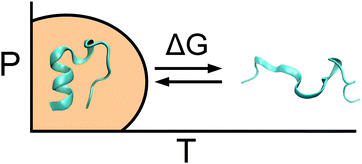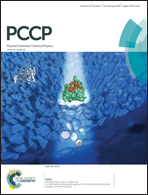Folding and unfolding thermodynamics of the TC10b Trp-cage miniprotein†
Abstract
We examine the folding–unfolding of a variant of the Trp-cage, known as TC10b, and compare structural stability, dynamics, and thermodynamics with that of the TC5b variant, using replica exchange molecular dynamics (REMD). The TC10b variant was designed to have larger helical stability by the substitution of amino acids with greater alpha helical propensities in the N-terminal region. Experiments have shown TC10b to possess larger overall stability than TC5b. Simulations starting from unbiased, unfolded initial conditions are run for 1 μs per replica. The calculations show a higher melting temperature for TC10b than TC5b, and suggest a more ordered folded structure through the elimination of a substate found in the folded ensemble of TC5b. We model the difference in Gibbs free energy, ΔG(P,T), of folding using the bootstrap statistical method, which is used to calculate uncertainties associated with the thermodynamic parameters for both variants of the Trp-cage. We find that while the shape of the area for which the protein is stability folded is elliptical for TC5b, there is a degree of uncertainty associated with that of TC10b, with one model suggesting elliptical and another suggesting hyperbolic. This model suggests that at high pressures, TC5b can experience pressure denaturation, but TC10b may not.


 Please wait while we load your content...
Please wait while we load your content...